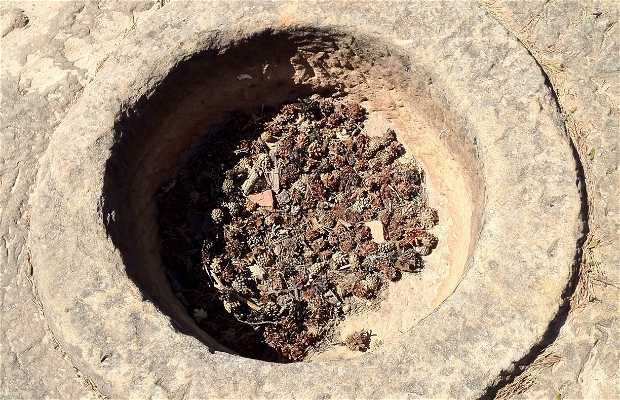El Viajero
Early medieval necropolis of the early...
Necrópolis altomedieval, de principios ...
Necrópolis altomedieval, de principios del siglo X, ubicada en un promontorio rocoso dentro de un espacio natural compartido por tres municipios distintos. Se compone de 139 tumbas antropomorfas excavadas en la roca, con restos de la planta de una ermita que fue construida en su parte superior.
Revenga es uno de los parajes naturales más importantes para el ocio familiar de la sierra burgalesa. En su parte exterior, junto a la carretera, se halla la ermita, el albergue y la Casa de la Madera. En teoría no se debe de circular en vehículo dentro del Comunero, pero si lo haces nadie te lo impedirá. A un kilómetro de distancia de la entrada, pasando sobre un carril de tierra y junto a diversos parques infantiles, se llega al yacimiento.
Está a mano izquierda. Es un roquedal que se encuentra vallado pero con acceso libre. Me llamó la atención el tamaño de las tumbas, una de ellas medía más de dos metros. En el sur lo habitual son las tumbas de incineración, aquí se nota que es inhumación. No obstante, en la parte superior de la roca existen algunos ustrinus, o huecos de pequeño tamaño posiblemente destinados a acoger cenizas de inhumación. Pero en ese lugar la reconquista instaló una ermita que ha eliminado la parte más antigua del yacimiento. Posiblemente con dicha iglesia se impuso la costumbre del enterramiento conservando el cuerpo, imprescindible para la futura resurrección de los muertos.
Las tumbas están vacías. Ni siquiera quedan señales de las losas que las cubrían. La publicidad del yacimiento alude a la existencia de grabados junto a la pila bautismal, pero cuesta identificarlos y son de dudosa atribución al mundo medieval.
Muy cerca del roquedal pasa el río Arlanza. Desde casi el centro de la roca hay un espacio con gran cantidad de musgo, señal de que en invierno emana una fuente. La relación entre el agua y la muerte es típica de todas las culturas antiguas, de hecho en el sur se suelen realizar estas tumbas en piedra directamente en los cauces de los ríos.
También me llamó la atención que una de las tumbas está excavada en la propia tierra. Asimismo es muy significativa la no existencia de cruces, ni de grabados con la identidad de los enterrados.
Early medieval necropolis of the early tenth century, located on a rocky promontory in a natural area shared by three different municipalities. It consists of 139 anthropomorphic tombs carved into the rock, with remains of the floor of a chapel that was built on top. Revenga is one of the most important natural places for family entertainment Burgos saw. On the outside, next to the road, is the chapel, the hostel and the House of Wood. In theory you should not circulate in the vehicle within the Communards, but if you do no one will prevent it. A mile away from the entrance, passing on a dirt track, and next to various playgrounds, you come to the site. It is on the left. It is a rocky area which is fenced but with free access. I was struck by the size of the tombs, one of which was over two meters. In southern usual cremation tombs are, here we see that is burial. However, in the top of the rock there are some ustrinus or possibly small holes intended to accommodate burial ash. But in that place the reconquest installed a chapel that has eliminated the oldest part of the site. Possibly with this church is the burial custom imposed preserving the body, essential for the future resurrection of the dead. The tombs are empty. Signals are not even slabs that covered. The publicity of the site refers to the existence of engravings with the font, but it costs identified and are of dubious attribution to the medieval world. Very close to the river Arlanza rocky passes. From almost the center of the rock there is a space with lots of moss, which signal emanates a source in winter. The relationship between water and death is common to all ancient cultures, in fact in the south are often made these stone graves directly in riverbeds. I also noticed that one of the tombs are carved into the earth itself. Also significant is the absence of crosses, or recorded with the identity of the buried.










